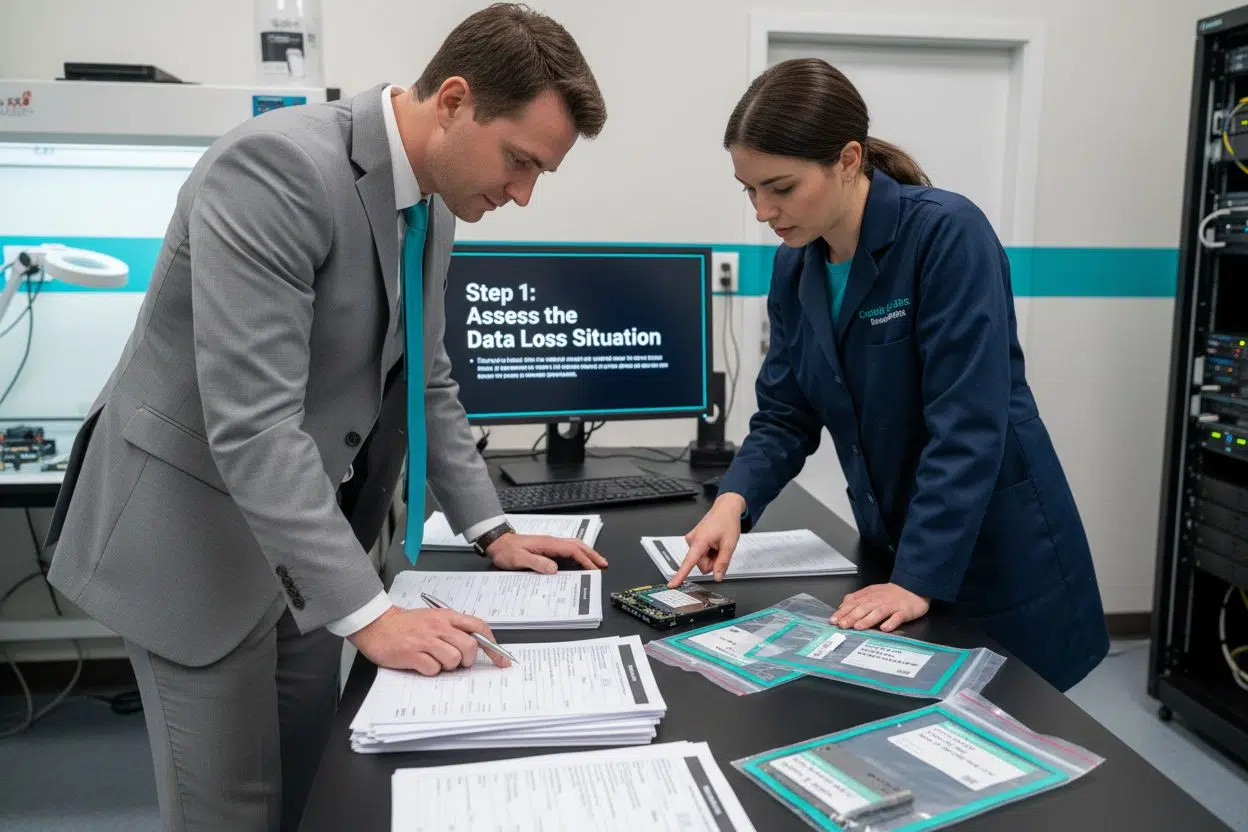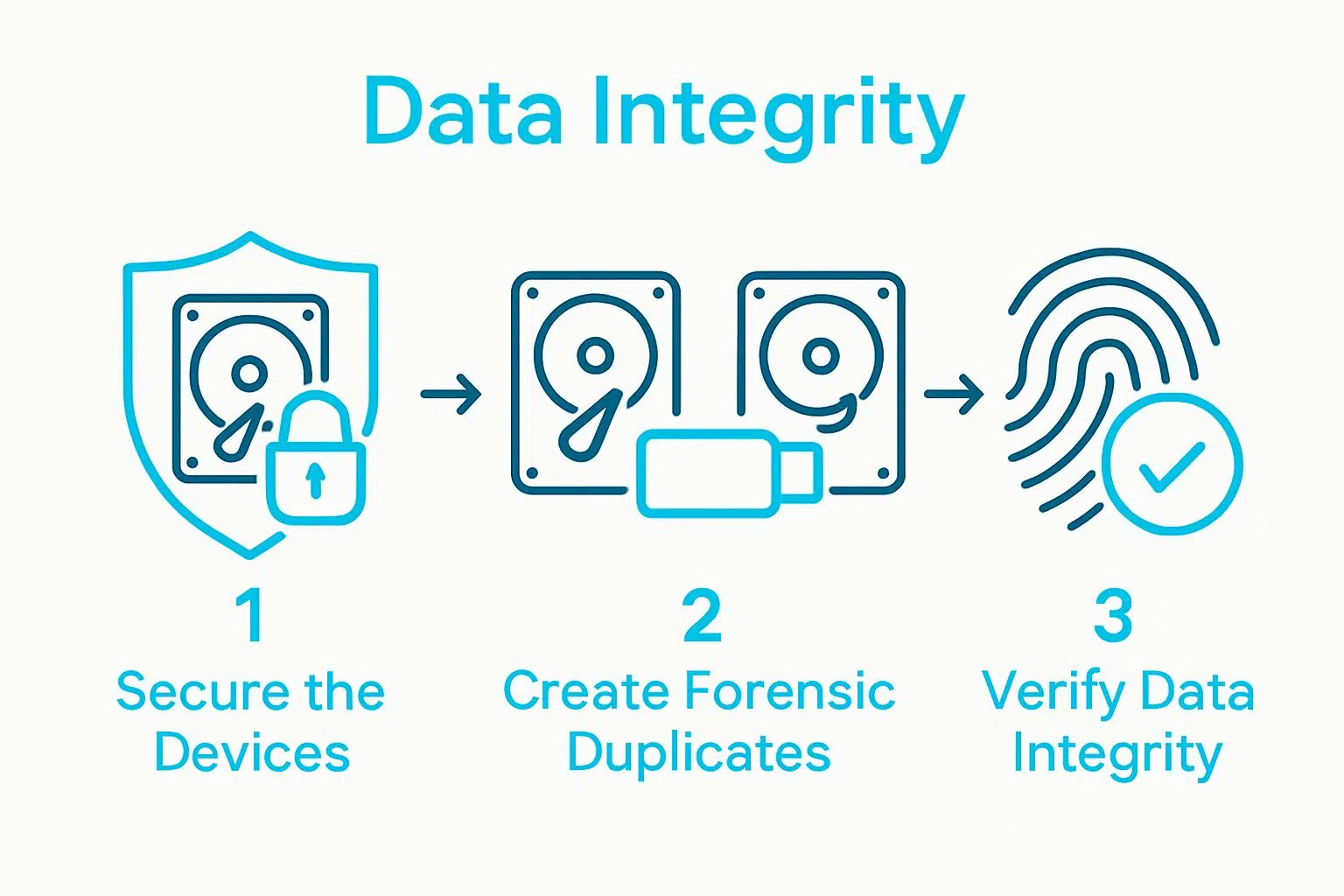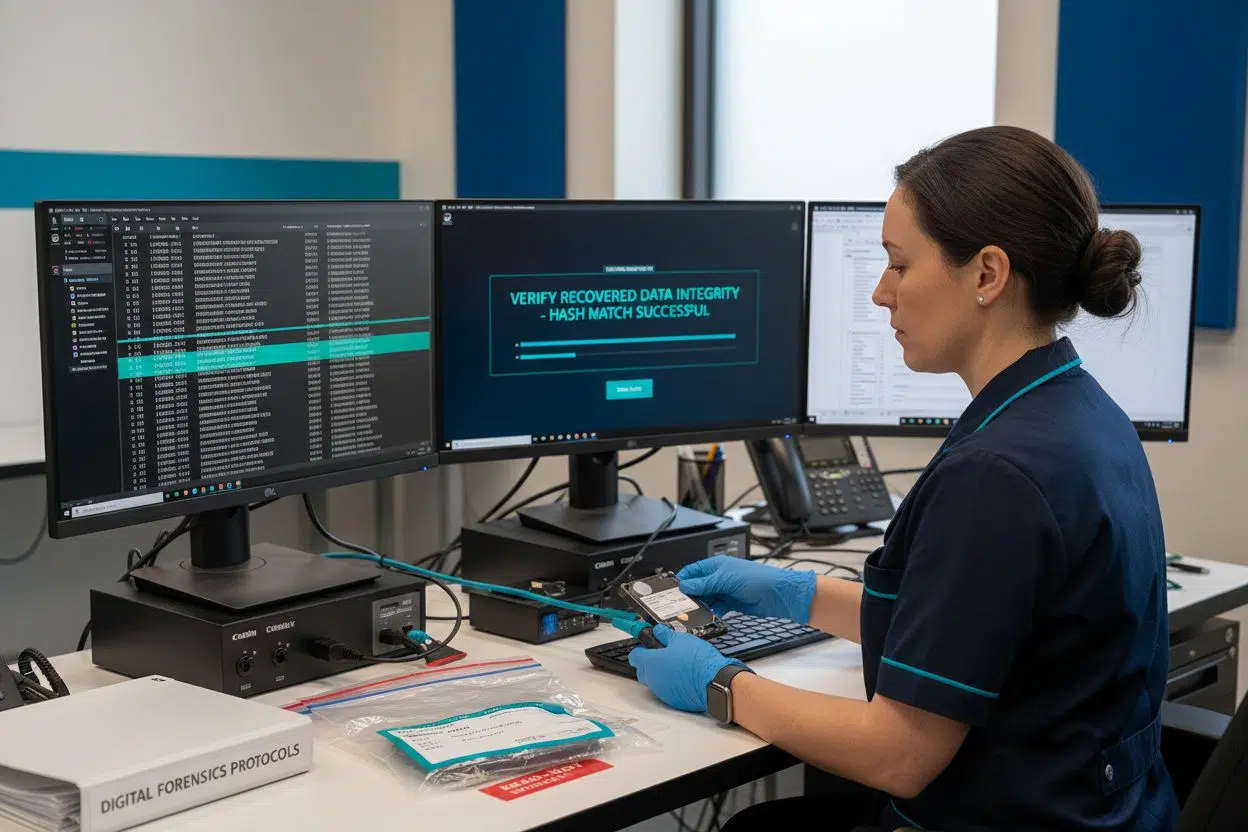Digital data loss leaves more than just empty folders behind and can derail entire legal cases in an instant. Most people assume that deleted files are simply gone forever. However, industry studies show that over 70 percent of lost digital evidence is fully recoverable if the right forensic procedures are followed from the start. This surprising gap between common belief and reality means getting those first steps right could change the outcome of your case. Understanding the essential steps of Forensic Data Recovery is crucial for legal professionals.
Table of Contents
- Step 1: Assess The Data Loss Situation
- Step 2: Secure The Affected Devices
- Step 3: Choose Appropriate Recovery Tools
- Step 4: Execute Data Recovery Procedures
- Step 5: Verify Recovered Data Integrity
- Step 6: Document The Recovery Process
Quick Summary
| Key Point | Explanation |
|---|---|
| 1. Document all data loss circumstances | Gather detailed accounts of when, where, and how the data loss occurred to guide recovery efforts effectively. |
| 2. Secure affected devices promptly | Isolate devices to prevent tampering and ensure evidence remains intact for legal processes. |
| 3. Select forensic tools carefully | Choose tools that maintain data integrity and compatibility with specific digital environments for effective recovery. |
| 4. Execute recovery on forensic copies | Conduct recovery procedures on duplicates, not originals, to protect evidence and avoid data modification. |
| 5. Document every step meticulously | Create a detailed report of the recovery process to demonstrate rigor and maintain legal admissibility of the findings. |
Step 1: Assess the Data Loss Situation
When a digital data loss incident occurs, the initial assessment becomes the foundation for successful forensic recovery. Legal professionals must approach this stage with methodical precision and strategic thinking. The primary goal of this first step is to gather comprehensive information about the data loss event without compromising potential evidence or risking further digital contamination.
The assessment begins by documenting the exact circumstances surrounding the data loss. This involves collecting detailed information from the involved parties about when, where, and how the data disappeared. Were files accidentally deleted? Has a storage device been physically damaged? Did a system crash trigger the loss? Each scenario demands a different forensic approach, making precise initial documentation critical.
Careful preservation of the original digital environment is paramount during this stage. Do not attempt random recovery techniques or allow untrained personnel to interact with the compromised system. Any unauthorized intervention could potentially overwrite critical forensic evidence or permanently destroy recoverable data. Digital forensic experts recommend creating a comprehensive incident report that captures all initial observations, device states, and potential data loss triggers.
Professionals should create a chronological timeline of events leading to the data loss, recording specific details such as:
- Exact date and time of suspected data loss
- Systems or devices involved
- User accounts or individuals potentially connected to the incident
- Any observed system anomalies or error messages
Through meticulous documentation and restrained intervention, legal professionals set the stage for successful forensic data recovery. This initial assessment provides digital forensics experts with the critical context needed to develop a targeted, effective recovery strategy tailored to the specific data loss scenario.
Successful completion of this step is characterised by a comprehensive incident report that objectively captures all known information, preserves the digital environment’s integrity, and provides a clear roadmap for subsequent forensic investigations.
Step 2: Secure the Affected Devices
Securing the affected digital devices represents a critical phase in forensic data recovery that demands unwavering attention to detail and strict procedural discipline. The primary objective of this step is to prevent any potential evidence tampering, data modification, or unintentional destruction of crucial digital information that might be essential for legal proceedings.
The initial action involves immediate physical isolation of all devices potentially connected to the data loss incident. This means disconnecting network cables, removing ethernet connections, and disabling wireless communication capabilities. Physical isolation prevents remote access, automatic updates, or potential external interventions that could inadvertently alter the digital forensic landscape.
Chain of custody becomes paramount during device handling. Each device must be treated as a potential piece of critical evidence. Professionals should wear clean, anti-static gloves and use evidence preservation bags when handling storage media. Documenting every interaction, including precise timestamps, handling personnel, and specific actions taken, creates a transparent record that can withstand legal scrutiny.
Creating forensic duplicates requires specialised write-blocking hardware to ensure absolute data integrity. These devices prevent any write operations while allowing complete, bit-by-bit forensic imaging. Professionals should create multiple backup copies using validated forensic imaging tools that generate cryptographic hash values, ensuring the absolute integrity of the original data source.
Critical verification steps include:
- Generating SHA-256 hash values for each forensic image
- Creating redundant backup copies stored in secure, segregated locations
- Documenting all imaging processes with precise technical metadata
Forensic experts recommend maintaining strict environmental controls during device preservation. This means storing devices in temperature-controlled environments, protecting them from electromagnetic interference, and preventing physical damage.
Successful completion of this step is characterised by meticulously documented device handling, forensically sound data imaging, and a comprehensive preservation strategy that maintains the evidentiary value of digital assets. Each action must be executed with precision, recognising that the smallest procedural misstep could compromise critical digital evidence.
Below is a table summarising critical device handling and imaging actions to be completed in the ‘Secure the Affected Devices’ phase so legal professionals can ensure forensic soundness.
| Task | Purpose | Key Details |
|---|---|---|
| Physical isolation of devices | Prevents unauthorised access or modification | Disconnect all networks and disable wireless |
| Use clean, anti-static gloves | Reduces risk of contamination | Wear suitable gloves when handling evidence |
| Evidence preservation bags | Protects media from environmental hazards | Place storage devices into specialised bags |
| Maintain chain of custody record | Documents all interactions for legal scrutiny | Record timestamps, handlers, and each action taken |
| Create forensic duplicates | Preserves original evidence integrity | Use write-blocking hardware and forensic imaging tools |
| Generate cryptographic hash values | Ensures duplicate integrity | Use SHA-256 or similar for each image created |
| Store backup copies securely | Guards against loss or tampering | Use separate, secure locations for redundant copies |
Step 3: Choose Appropriate Recovery Tools
Selecting the right forensic data recovery tools represents a critical decision that can make or break the entire investigation. Legal professionals must approach tool selection with strategic precision, understanding that each digital forensics scenario demands a unique technological approach tailored to specific data loss circumstances.
Forensic tool selection begins with a comprehensive assessment of the initial data loss environment. The tools must align precisely with the storage media type, operating system, and specific data loss scenario. Professional-grade forensic tools differ significantly from consumer-level recovery software, offering advanced capabilities that preserve legal admissibility and maintain strict evidence integrity.
Read-only forensic tools become paramount in maintaining the original data’s untouched status. These specialised utilities create bit-by-bit forensic images without modifying the source media, ensuring that every microscopic data fragment remains preserved for potential legal proceedings. Professionals should prioritise tools that generate cryptographic hash values, providing verifiable proof of data authenticity and preventing potential challenges to evidence reliability.
Consider the following critical tool selection criteria:
- Compatibility with multiple storage media types
- Ability to generate forensically sound duplicate images
- Comprehensive metadata preservation capabilities
- Support for various file system formats
- Robust reporting and documentation features
Digital forensic experts recommend selecting tools that provide comprehensive analysis capabilities, enabling investigators to reconstruct digital timelines, recover deleted files, and extract hidden metadata. Advanced tools can penetrate complex storage environments, including encrypted drives, fragmented file systems, and damaged storage media.
Successful tool selection is characterised by a methodical approach that matches technological capabilities with specific investigative requirements. The chosen tools must not only recover data but also maintain a rigorous chain of custody, ensuring that every recovered byte can withstand potential legal scrutiny. Legal professionals should consult with digital forensics specialists to validate tool selection and ensure the most appropriate technological approach for their specific case.
Step 4: Execute Data Recovery Procedures
Executing data recovery procedures represents the most technically intricate phase of digital forensic investigation, where theoretical preparation transforms into precise technical action. Legal professionals must understand that this step demands meticulous attention, combining sophisticated technological skills with systematic investigative methodology.
The recovery process begins with creating forensic working copies of the original media, ensuring that all subsequent actions occur on duplicated datasets rather than original evidence. Professionals must utilise write-blocking technologies to prevent any potential data modification during the recovery process. This approach guarantees the legal admissibility of recovered information, maintaining a pristine chain of custody that can withstand rigorous judicial scrutiny.
Structured recovery strategies involve multiple layers of investigative techniques. Initial approaches focus on logical recovery methods, which attempt to restore file system structures and recover deleted or fragmented files through specialised software algorithms. When logical methods prove insufficient, professionals may transition to more advanced physical data reconstruction techniques that examine raw magnetic or solid-state storage at the binary level.
Critical recovery procedure elements include:
- Systematic sector-by-sector data scanning
- Metadata reconstruction techniques
- File signature identification
- Fragmented file reassembly processes
- Cryptographic hash verification of recovered data
Forensic experts recommend implementing multi-layered recovery strategies that combine automated tools with manual investigative techniques. This approach allows professionals to navigate complex data loss scenarios, recovering information that automated systems might overlook.
Successful data recovery is characterised by a comprehensive, documented process that not only retrieves lost data but also provides a transparent narrative of how the recovery was achieved. Each recovered file must be meticulously logged, with precise details about its origin, recovery method, and forensic validation. The ultimate goal extends beyond mere data retrieval, focusing on creating a legally defensible reconstruction of digital evidence that can withstand intense professional and judicial scrutiny.
Step 5: Verify Recovered Data Integrity
Verifying the integrity of recovered digital data represents the critical final checkpoint in forensic data recovery, where legal professionals transform raw digital information into reliable, admissible evidence. This step transcends simple data retrieval, focusing instead on establishing absolute confidence in the authenticity and completeness of the recovered digital assets.
The verification process begins with cryptographic hash comparison, a forensically rigorous method that generates unique mathematical fingerprints of the original and recovered datasets. Professionals generate multiple hash values using algorithms like SHA-256, comparing these values across different stages of recovery to detect even the most microscopic alterations. Bit-level precision becomes paramount, ensuring that every digital fragment remains unchanged throughout the recovery process.
Comprehensive integrity verification involves multiple sophisticated techniques beyond simple hash comparisons. Professionals must conduct thorough metadata analysis, examining file creation timestamps, access permissions, and embedded system information. These detailed examinations provide a comprehensive narrative of the data’s provenance, creating a transparent digital timeline that can withstand intense legal scrutiny.
Critical verification steps include:
- Generation of multiple cryptographic hash values
- Cross-referencing recovered file metadata
- Comparative analysis of original and recovered data structures
- Comprehensive file signature validation
- Detailed forensic logging of verification processes
Digital forensic experts emphasise the importance of systematic integrity verification as a fundamental aspect of maintaining legal admissibility. The verification process must produce comprehensive documentation that demonstrates an unbroken chain of digital evidence preservation.
Successful data integrity verification is characterised by a meticulously documented process that proves, beyond reasonable doubt, that the recovered data remains precisely identical to its original state. Legal professionals must view this step not merely as a technical procedure, but as a critical mechanism for transforming raw digital information into credible, defensible evidence capable of withstanding rigorous judicial examination.
The following table provides an overview checklist of core integrity verification steps legal professionals must complete to ensure all recovered data is admissible in court.
| Verification Step | Description | Outcome |
|---|---|---|
| Cryptographic hash comparison | Compare hash values of original and recovered | Confirms data unchanged during recovery |
| File metadata cross-referencing | Examine timestamps and permissions | Validates provenance and integrity of recovered files |
| Comparative analysis of file structures | Inspect original and restored data structures | Reveals inconsistencies or loss during recovery |
| File signature validation | Confirm files match original format/type | Detects potential corruption or manipulation |
| Detailed forensic logging | Document each verification stage | Provides a complete, auditable verification record |
Step 6: Document the Recovery Process
Documenting the forensic data recovery process represents the critical final narrative that transforms technical actions into legally defensible evidence. This step goes far beyond simple record-keeping, serving as a comprehensive technical and legal document that articulates every nuanced action taken during the digital investigation.
Forensic documentation must be exhaustively detailed, creating a transparent chronological record that reconstructs the entire recovery journey. Legal professionals should approach documentation as a meticulous storytelling exercise, where each technological action is explained with scientific precision and legal clarity. The documentation becomes the primary mechanism through which the integrity and reliability of recovered digital evidence can be communicated and validated.
The documentation process requires creating a comprehensive forensic report that includes precise technical metadata, step-by-step procedural descriptions, and forensically validated findings. This report must capture not just the successful outcomes, but also document any challenges encountered, tools utilised, and the specific methodological approaches employed during the recovery process. Professionals must maintain an objective, neutral tone that prioritises factual accuracy over interpretative speculation.
Critical documentation elements include:
- Detailed timeline of recovery actions
- Specific tools and technologies deployed
- Hash values and integrity verification results
- Challenges and mitigation strategies encountered
- Expert analysis and preliminary findings
- Chain of custody documentation
Forensic experts underscore the importance of creating comprehensive, defensible documentation that can withstand intense judicial scrutiny. The documentation serves multiple critical functions beyond immediate case requirements, potentially establishing precedent and supporting future digital forensic investigations.
Successful documentation is characterised by a report that is simultaneously technically rigorous and legally intelligible. The final document must communicate complex technical processes in a manner accessible to legal professionals, judges, and juries, transforming raw digital forensic work into a compelling, credible narrative of digital evidence discovery and preservation.
Transform Uncertainty into Reliable Evidence with Specialist Forensic Support
Legal professionals often face immense pressure when digital data loss threatens a case. Every misstep in the recovery process risks damaging crucial evidence or even jeopardising your client’s outcome. The steps detailed in this article—precise assessment, device securing, selecting the right recovery tools, systematic procedures, integrity verification, and meticulous documentation—highlight just how complex and delicate forensic data recovery truly is.
When you need confidence that your evidence will withstand legal scrutiny, trust Forensic Computing Investigation specialists who do more than just recover lost files. At Computer Forensics Lab, our expert digital forensics examiners provide unparalleled data recovery for legal contexts, delivering clear chain of custody and expert witness support. Move from doubt to certainty—visit our main site and see how your next case can benefit from comprehensive digital forensic solutions designed for the demands of courts and investigations. Act now to protect your evidence and secure your advantage.
Frequently Asked Questions
What are the first steps in forensic data recovery for legal professionals?
The first step in forensic data recovery involves assessing the data loss situation, which includes documenting the circumstances surrounding the data loss, preserving the original digital environment, and creating a comprehensive incident report with critical details.
Why is securing affected devices important in forensic data recovery?
Securing affected devices prevents evidence tampering or data modification. Immediate physical isolation of devices, maintaining a strict chain of custody, and using proper handling techniques are essential to protect the integrity of digital evidence.
How do I choose the right forensic recovery tools?
Choosing the right forensic recovery tools requires assessing the data loss environment. Tools must be compatible with the storage media, operating system, and specific data loss scenarios. Professional-grade forensic tools are preferred for their ability to preserve legal admissibility and evidence integrity.
What is involved in verifying recovered data integrity?
Verifying recovered data integrity involves comparing cryptographic hash values of the original and recovered datasets, conducting metadata analysis, and ensuring that every element of the recovered data maintains its authenticity and completeness for use in legal proceedings.


